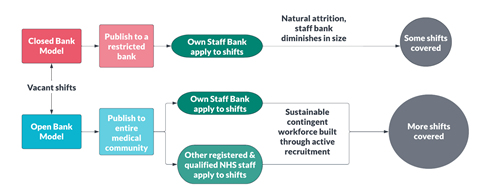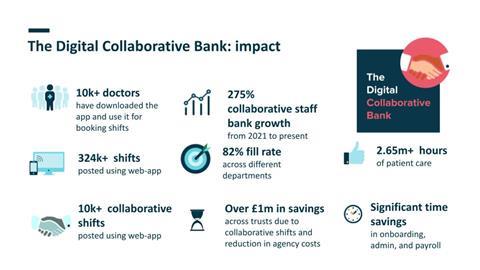Dr Ahmed Shahrabani, co-founder of Locum’s Nest, explores how open workforce technology transforms NHS staff wellbeing while having a positive impact for NHS trusts
Workforce technology solutions have immense potential to streamline processes in the NHS, leading to increased efficiency and improved service delivery. Beyond that, they also play a crucial role in supporting staff wellbeing, addressing the mounting pressures the healthcare workforce faces. While there is no single solution, implementing the right workforce technology can bring numerous benefits, positively impacting the NHS staff’s overall wellbeing.
Sponsored by
We explore how with an open bank model, workforce technology can transform staff wellbeing by simplifying processes, enhancing planning, promoting transparency, supporting flexible working arrangements, and fostering collaboration; ultimately meaning NHS staff can focus their energy on what matters most – patient quality and continuity of care. The latest NHS Long Term Workforce plan notes a clear “correlation between staff health and wellbeing and patient outcomes.”

We delve into five fundamental ways workforce technology solutions support the healthcare workforce with an open bank model:
1. Simplifying processes: less admin burden and happier teams
By leveraging automated processes, such as shift scheduling and payroll processing, workforce technology reduces the administrative burden on NHS employees. Shifting from paper-based timesheets to digital e-timesheets streamlines the payroll process, providing peace of mind for healthcare professionals and reducing administrative queries. This efficient system enables staff to get paid quicker, simplifies expense management, and offers a reliable auditable trail. Streamlining processes across departments and organisations minimises reliance on disparate systems, creating a seamless experience.
2. Enhanced planning: fewer bleeps and last minute requests
Open workforce technology empowers staffing teams with real-time data and accurate workforce insights, enabling effective shift management in advance. This proactive approach reduces last-minute requests and bleeps for healthcare professionals, fostering a planned and well-organised work environment. The reduction in retrospective shifts at trusts relieves pressure on healthcare professionals and grants them better control and understanding of shift planning.
Improved planning also minimises uncertainty and increases transparency throughout the process. With our workforce technology, 90 per cent of shifts are planned and published in advance in the job listings. Planning shifts means healthcare professionals can plan their lives better, whilst hospital managers are enabled to better plan their rotas meaning fewer last-minute struggles to fill gaps.
3. Fostering the power of collaboration: #1NHS1StaffBank
Collaboration among different NHS organisations broadens the available shifts for staff and facilitates knowledge exchange. Open workforce technology enables healthcare professionals to work shifts in other organisations, expanding their expertise and offering new opportunities. Utilising Digital Passport information, such as compliance and General Medical Council records, ensures instant HR compliance checks for clinicians from neighbouring organisations. This streamlines the onboarding process, reduces administrative time and costs, and boosts shift fill rates. Compliance documents can be shared across organisations as part of a collaborative staff bank, ensuring seamless access to necessary information while importantly maintaining data security and privacy.
The Digital Collaborative Bank truly fosters the power of collaboration via an open bank model:

4. Support flexible working arrangements: engaged and autonomous staff
Open workforce technology offers increased flexibility and visibility of shifts for both staffing teams and healthcare professionals. This empowers healthcare professionals to choose shifts that align with their personal lives, improving work-life balance and engagement. Reduced pressure to fill vacancies allows staff to take ownership of their schedules and apply for shifts that suit them best.
By granting control and autonomy, the technology contributes to staff satisfaction and provides a sense of empowerment. I have seen and felt this myself working bank shifts across University College London Hospital, the Whittington hospital sites, and Camden and Islington Foundation Trust’s community sites within Psychiatry.
5. Increased communication and transparency: better relationships and trust
Promoting transparency through workforce technology enhances the relationship between healthcare professionals and staffing teams. Clear information regarding open shifts and compensation builds trust and cultivates a shared understanding of each other’s needs. Standardised rates and rate-escalation processes set by organisations ensure transparency in advertised rates, aligning with policies applied across public bodies. This fosters an environment of trust and fairness while maintaining a dedicated and engaged workforce.
Ultimately, open workforce technology holds tremendous potential to transform staff wellbeing in the NHS. By simplifying processes, enhancing planning, promoting transparency, supporting flexibility, and fostering collaboration, the technology streamlines operations, empowers staff and creates a sense of ownership and autonomy.
As NHS leaders and executives further embrace open bank model workforce technology, we will help unlock the benefits of a collaborative, efficient, and satisfied workforce. Together, we can address the challenges facing the NHS and improve the wellbeing of its invaluable staff.
Are you intrigued to learn more about how workforce technology can support the wellness and wellbeing of staff in your NHS organisation? Get in touch by booking a discovery call with our friendly and knowledgeable team.

Harnessing open workforce technology to enhance NHS staff wellbeing

Dr Ahmed Shahrabani, co-founder of Locum’s Nest, explores how open workforce technology transforms NHS staff wellbeing while having a positive impact for NHS trusts
 Currently
reading
Currently
reading
Harnessing open workforce technology to enhance NHS staff wellbeing
- 2
- 3
- 4
- 5







































